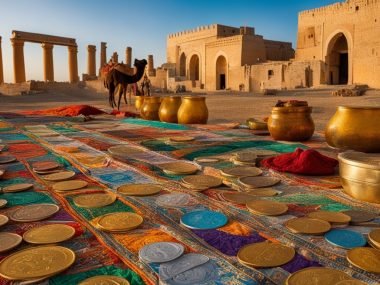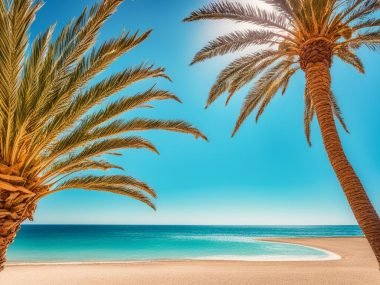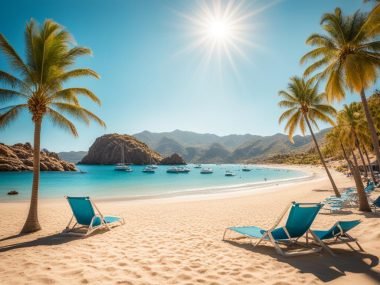In January, Tunisia can be very cold or quite warm. Temperature varies a lot across the country. For example, it can be as cold as -5°C in Ain Drahem or as warm as 20°C in Tozeur. Such weather variety makes Tunisia a special place for a winter holiday. Even though January is cold and wet, it’s a great time for those who like quiet adventures and few tourists.
Tunisia is known for its rich history and different landscapes. This includes beaches and the big Sahara Desert. In January, Tunisia is peaceful, offering a beauty that’s hard to find when lots of tourists are around. The weather might change a lot, but it lets you see different parts of the country.
Thinking about visiting Tunisia in January? Then remember to pack for changing weather. Temperatures usually go from 8.5°C to 16.2°C. But it can get much colder or warmer. This time of year is not very busy, so you can meet locals and see Tunisia’s historical places without crowds.
Key Takeaways
- Expect temperatures between -5°C and 20°C, making it essential to pack for varied weather conditions.
- January is the coldest and wettest month in Tunisia, offering a tranquil tourism experience.
- Fewer tourists mean more intimate cultural encounters and quieter sightseeing experiences.
- Diverse landscapes and historical sites make Tunisia a compelling destination even in the winter months.
- Tunisia vacation planning for January requires flexibility due to its unpredictable climate.
- The range of temperatures provides the opportunity to experience different aspects of Tunisia’s unique environment.
Introduction to Tunisia’s Climate
Planning your trip to Tunisia? It’s good to know about its climate first. The north coast has a Mediterranean weather. The central and eastern parts are drier. Towards the south, it gets very hot and dry.
Overview of Tunisia’s Weather Patterns
When to visit Tunisia depends on the weather you like. Summers in Mediterranean areas are hot and dry. Winters are mild and rainy. This is perfect for beach lovers and history fans. The centre and south have little rain and big changes in temperature.
Climate Variations Across Regions
Tunisia’s weather changes a lot from north to south. The north and coast get lots of rain, over 700 mm a year. But, as you go south, it gets much drier, getting less than 100 mm a year.
Knowing these differences helps you plan your trip better. You can choose when and where to visit based on what you like to do. The coast offers nice weather for a relaxing holiday. For adventure seekers, the steppe and Sahara offer tough but exciting conditions.
Tunisia Weather in January
Thinking about going to Tunisia in January? It’s important to know the weather. The weather varies a lot, and being ready can make your trip better.
Average Temperature
In January, temperatures in Tunisia differ based on where you are. In the north and by the coast, it’s usually between 8°C and 16°C. But, some places get much colder or warmer. For example, Ayn Draham might drop to -5°C, but Tozeur could get up to 20°C.
Rainfall and Humidity
January sees rainfall averaging 56 to 59.3 mm. This means more humidity in Tunisia. If you’re visiting both the north and the south, you’ll need to plan well. Places like Douz and Tozeur are drier but can still get cold at night. So, it’s smart to be ready for both warm days and cool evenings.

Benefits of Visiting Tunisia in January
Visiting Tunisia in January has lots of perks for travellers. After the holiday season, there are fewer tourists. This makes it easier to see places without crowds.
Fewer Crowds and Lower Tourist Activity
Less tourists mean you can enjoy sights more calmly. You’ll find peace at historical spots, museums, and markets. You get to learn about local culture without rush.
This is great for seeing ancient ruins like Carthage or the medinas in Tunis. It’s easier and nicer without lots of people.
Reduced Travel Costs
Travel costs drop in January too. Hotels and tours often cut their prices. This means you can save money or stay longer.
You can do more with your money, like try new activities. January in Tunisia lets you enjoy your trip more and spend less.
So, planning a trip to Tunisia in January is smart. It’s calmer and cheaper. It’s perfect for those who love culture and saving money.
Popular Attractions in January
January is great for visiting Tunisia’s famous spots with fewer people around. The weather is nice, perfect for seeing Tunisia’s culture and history. It’s a great time to go.
Exploring Tunis
In Tunis, the capital, there are lots of places to see in January. The medina is a UNESCO World Heritage Site. It has busy, narrow streets full of life. The Bardo Museum has amazing mosaics to see. Markets and old buildings look lovely in Tunisia’s winter.
Visiting Ancient Carthage
History buffs will love Ancient Carthage. The ruins show what Punic and Roman times were like. There are fewer tourists in January. It’s cooler, so it’s nicer to see places like the Roman amphitheatre and Antonine Baths. The Carthage National Museum is also a must-see.

Sahara Desert Excursions
January is still a good time for the Sahara Desert, despite cold nights. Avoiding the summer heat, you can have an amazing adventure. The Sahara’s vast landscapes and starry nights are magical. Camel treks or 4×4 rides offer stunning views you won’t forget.
Activities to Enjoy During January
Visiting Tunisia in January is unique and fun. It’s cooler, so you can do many fun things. Visitors can really enjoy their stay.
Outdoor Adventures
The cooler January weather is perfect for outdoor fun in Tunisia. You can go hiking in the Khroumirie mountains. These mountains are beautiful. Bird lovers can also watch different birds. Tunisia is great for seeing birds in January.
Historical Sites and Museums
Tunisia has a lot of history to explore in January. At the Bardo Museum, you can see Roman mosaics. Dougga is a place you should not miss. It shows Tunisia’s old stories.
Cultural Experiences
For cultural fun, visit the markets like Souk El Attarine in Tunis. You can find spices, crafts, and textiles. January is a calm time to try Tunisian food in cooking classes. Talking with locals and going to village festivals teaches you about Tunisian culture.
Tunisia Travel Tips for January
Before you go to Tunisia in January, think about the weather and what you need. Here are tips to make your trip smooth and fun.
Packing Recommendations
For packing for Tunisia in January, be ready for different weather. You’ll need warm clothes for cold nights and lighter ones for the day. You should bring:
- Warm jackets and sweaters for evenings
- Light layers such as t-shirts and long-sleeve tops for daytimes
- Comfortable walking shoes for exploring sites
- Rain gear like waterproof jackets, in case of showers
- Accessories like hats and scarves for added warmth
Travel Safety Considerations
For safe travel in Tunisia, take some important steps. Always drink enough water, especially in the desert. Carry a lot of water with you. Respect local customs and know the holidays like Eid al-Fitr and Eid al-Adha when some places might close.
This table shows important tips for a safe and fun trip:
| Aspect | Recommendation |
|---|---|
| Hydration | Carry plenty of water, particularly for desert excursions |
| Holiday Awareness | Be aware of local holidays and service availability |
| Clothing | Dress appropriately for variable temperatures |
| Local Etiquette | Respect cultural practices and dress modestly |
Make sure your travel insurance is up-to-date. It should cover your activities in Tunisia. With these Tunisia travel tips, your trip can be safe and unforgettable.
Weather Considerations for January Travel
Planning a vacation to Tunisia in January means thinking about the weather. The weather changes a lot, so you need to be ready. It helps make sure your trip is fun and comfortable.
Packing Warm Clothes
Evenings in Tunisia can get pretty cold in January. Places like Ain Drahem get especially chilly. So, be sure to pack warm things. Bring layers like jumpers, thermal clothes, and even a cosy hat and gloves for the cold nights.
Preparing for Unpredictable Weather
The weather in Tunisia can change fast in January. You might face rain or quick changes in how warm or cold it is. Make sure to pack waterproof coats and strong shoes that keep water out. Being ready means you won’t be stopped by sudden bad weather. This way, you can enjoy your travels with no worries about the weather.
The Best Places to Stay in Tunisia in January
Visiting Tunisia in January offers many places to stay, fitting all likes and budgets. You’ll find it easy to get a comfy and cheap spot due to fewer tourists. Look for luxury resorts or boutique hotels to stay warm.
Accommodation Options
Luxury resorts by the sea and cozy guesthouses are great in January. You can stay in nicer places without spending much. City centre guesthouses and boutique hotels let you see the local way of life up close.
Recommended Areas
Picking where to stay can make your trip to Tunisia special. In Tunis, explore the old Medina and lively markets for a rich experience. Coastal towns like Sidi Bou Said offer beautiful views for a calm stay.
Tozeur is great for desert lovers, with easy access to the Sahara. Choosing the right place lets you enjoy what each area is known for. This way, your visit in January will be fun and unforgettable.







